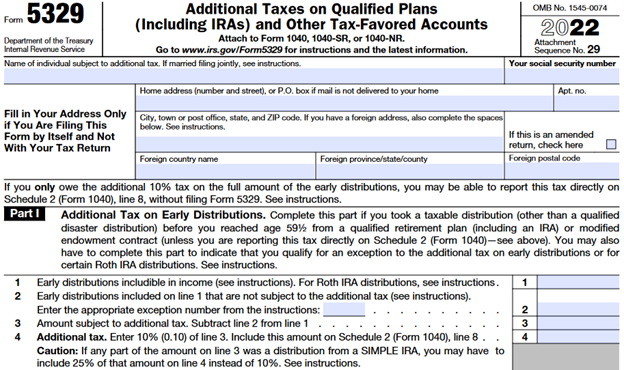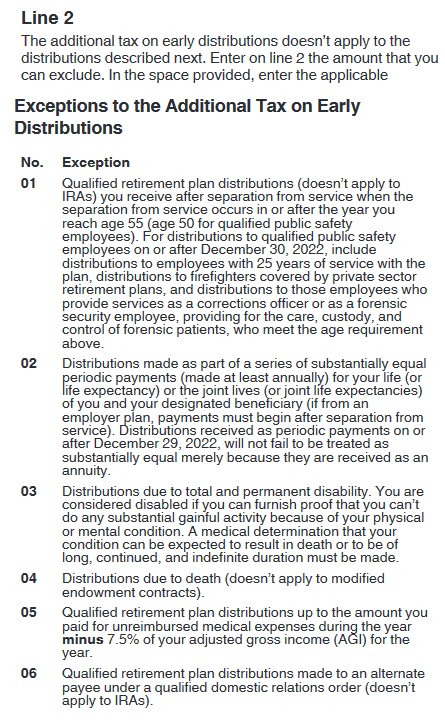Modification of Eligible Age for Exemption from Early TSP Withdrawal Penalty for Qualified Public Safety Employees

Prior to the passage of SECURE Act 2.0, the Defending Public Safety Employees Retirement Act of 2015, allowed specified federal employees who are law enforcement officers (LEOs), customs and border protection officers (CBPOs), federal firefighters (FFs), and air traffic controllers (ATCs) to access their traditional TSP accounts before age 55. Public safety employees are also classified as “special provision” employees. Before the passage of SECURE Act 2.0, special provision employees could make penalty-free withdrawals from their traditional TSP accounts if they retired from federal service during or after the year they become age 50. Note that under the Internal Revenue Code, an employee who participates in a qualified retirement such as a 401(k) qualified retirement plan or the TSP can avoid a 10 percent early withdrawal penalty when making retirement plan withdrawals but only if they are at least age 55. But the Defending Public Safety Employees Retirement Act of 2015 changed the minimum age from age 55 to age 50 for public safety employees including special provision employees.
Learn more about your benefits and retirement planning at our No-Cost webinars, featuring Ed Zurndorfer -
This provision resulting from the SECURE Act 2.0 passage is effective for traditional TSP distributions to retiring federal public safety employees made after December 29,2022.
Determining Eligibility for the 10% Early Withdrawal Penalty Exception Under SECURE 2.0
It is the responsibility of individual federal employing agencies to determine whether a TSP participant is a public safety employee. The TSP does not have the necessary information to make that determination. Public safety employees include: (1) LEOs; (2) FFs; (3) ATCs; and (4) CBPOs. Like all federal employees, these employees are identified according to their job classification on their SF 50 (Notice of Personnel Action) Box 30. The following table summarizes the job classification codes for LEO’s, FFs, ATCs, and CBPOs, as shown in Box 30 of their SF 50.
| FERS Retirement Plan (Depends On When An Employee Was Hired) |
Employee Occupation | SF 50 Box 30 Code |
| FERS (employee hired before 1/1/2013) | LEO and FF | M |
| ATC | L | |
| CBPO | O | |
| FERS-RAE (employee hired during 2013) | LEO and FF | MR |
| ATC | LR | |
| CBPO | OR | |
| FERS-FRAE (employee hired after 12/31/2013) | LEO and FF | MF |
| ATC | LF | |
| CBPO | OF |
When a public safety employee separates from federal service, the employee’s servicing payroll office must submit to the TSP an Employee Data Record (EDR) containing a “P” employment code and the appropriate employment code date corresponding to the date of separation. Agencies should submit the “P” code regardless of the employee’s age.
The TSP will treat TSP participant who meet the following three criteria as eligible for the exemption from the 10 percent withdrawal penalty for distributions made from the traditional TSP:
- Identified by their employing agencies as a public safety employee through the “P” code, AND
- Determined by the TSP to have separated during after they become age 50 (based on their date of birth); OR
- Have at least 25 years of service between their TSP service computation date (SCD) and their “P” Employment Code date corresponding to their date of separation, both of which were received from the TSP participant’s payroll process agency.
The following two examples illustrate public safety employee who are eligible for exemption from the early withdrawal penalty from the traditional TSP:
Example 1. Jason, age 45, entered federal service as a firefighter on August 31, 1998. His SF 50 Box 30 code is “M” and his Service Computation Date (SCD) for retirement is August 31, 1998. Jason’s agency identifies Jason as a public service employee with a “P” Code. In addition, since Jason has 25 years of federal service as a federal firefighter, he is eligible to retire as of August 31, 2023. Under SECURE Act 2.0, If Jason retires on August 31, 2023, he can immediately make penalty-free withdrawals from his traditional TSP account.
Example 2. Francine, age 51, entered federal service as a law enforcement officer on September 15,2003 at the age of 31. Her SF 50 Box 30 Code is “M” and her Service Computation Date (SCD) for retirement is September 15, 2003. Francine’s agency identifies Francine as a public service employee with a “P” code. In addition, since Francine will have 20 years of federal law enforcement officer service as of September 15,2023 and she is over age 50, Francine will be eligible to retire as of September 15, 2023. Under SECURE Act 2.0 (and the Defending Public Safety Employees Retirement Act of 2015) when Francine retires at age 51, she will be eligible to immediately make penalty-free withdrawals from her traditional TSP account.
Requesting a Penalty-Free Traditional TSP Withdrawal
Public safety employees who retire from federal service with a “P” code and who want to make penalty-free withdrawals from their traditional TSP must request these withdrawals online, using their TSP online accounts.
Penalty-free withdrawals apply only to the traditional TSP account. If a public safety employee has a Roth TSP account, then the employee will have to wait until age 59.5 to make a penalty-free and income tax-free withdrawal from his or her Roth TSP account. Public safety employees will therefore have to specify which TSP account they are requesting withdrawals. If they do not, then the TSP will withdraw the retiring employee’s TSP funds “pro-rata” according to the traditional TSP and Roth TSP account balances.
Tax Reporting
When a separated TSP participant requests a withdrawal, the TSP system will use the “P” Employment Code, date of birth (DOB) and Service Computation Date, to determine whether the TSP participant is eligible for an exemption from the early withdrawal penalty. In January of the year following the distribution, the TSP will issue a 1099-R that accurately reflects a qualifying public safety employee’s exemption from the early withdrawal penalty, provided the TSP participant has the “P” code from the agency and has met the age or years of service requirement.
If a public safety employee’s agency does not identify the employee as a public safety employee by sending the “P” code, the TSP 1099-R will not reflect an exemption to the early withdrawal penalty. In this case, qualifying retired public service employees can claim the exemption from the early withdrawal penalty by filing IRS Form 5329 (Additional Taxes on Qualified Plans) directly with the IRS when they file federal income return for the year the traditional TSP withdrawal was made. See below IRS Form 5329 together with the instructions for reporting the exception (Part I line 2 of Form 5329) to the 10 percent early withdrawal penalty.


Edward A. Zurndorfer is a CERTIFIED FINANCIAL PLANNER™ professional, Chartered Life Underwriter, Chartered Financial Consultant, Chartered Federal Employee Benefits Consultant, Certified Employees Benefits Specialist and IRS Enrolled Agent in Silver Spring, MD. Tax planning, Federal employee benefits, retirement and insurance consulting services offered through EZ Accounting and Financial Services, and EZ Federal Benefits Seminars, located at 833 Bromley Street - Suite A, Silver Spring, MD 20902-3019 and telephone number 301-681-1652. Raymond James is not affiliated with and does not endorse the opinions or services of Edward A. Zurndorfer or EZ Accounting and Financial Services. The information has been obtained from sources considered to be reliable, but we do not guarantee that the foregoing material is accurate or complete. While we are familiar with the tax provisions of the issues presented herein, as Financial Advisors of RJFS, we are not qualified to render advice on tax or legal matters. You should discuss tax or legal matters with the appropriate professional.



